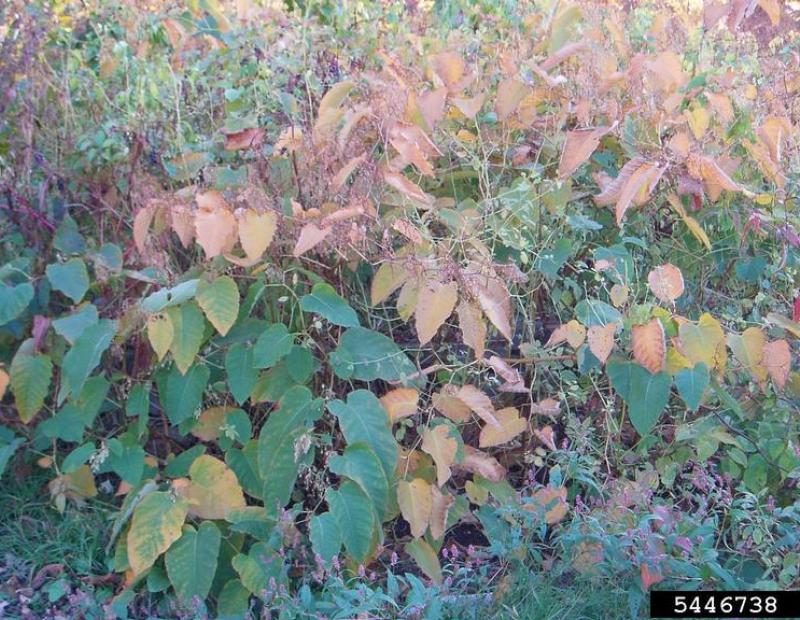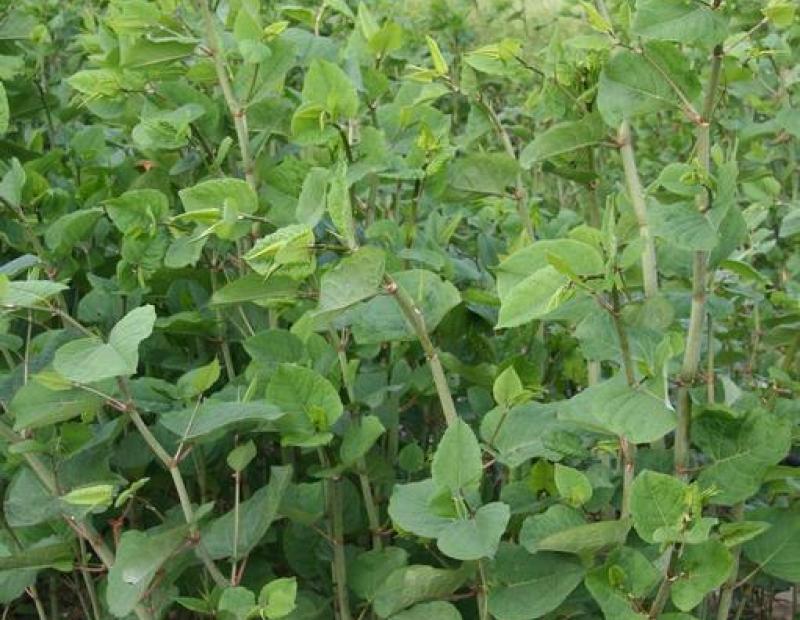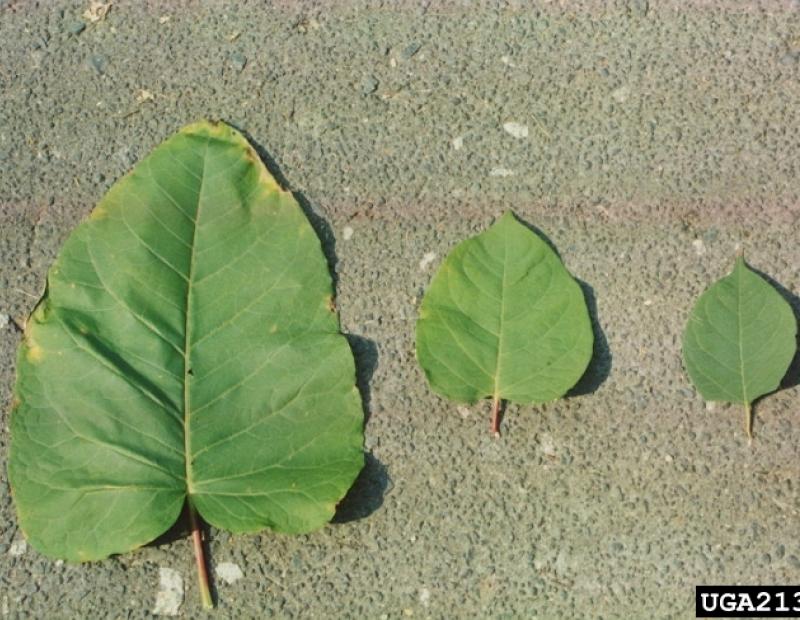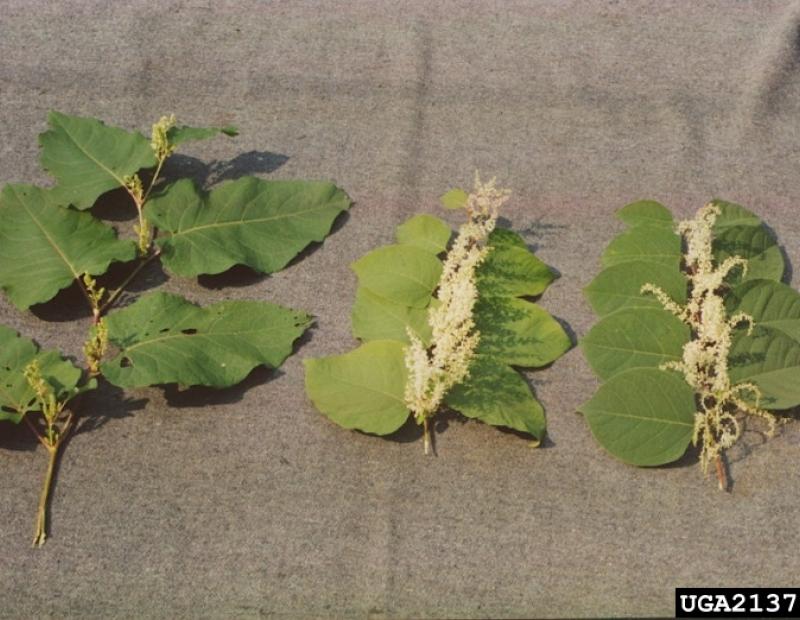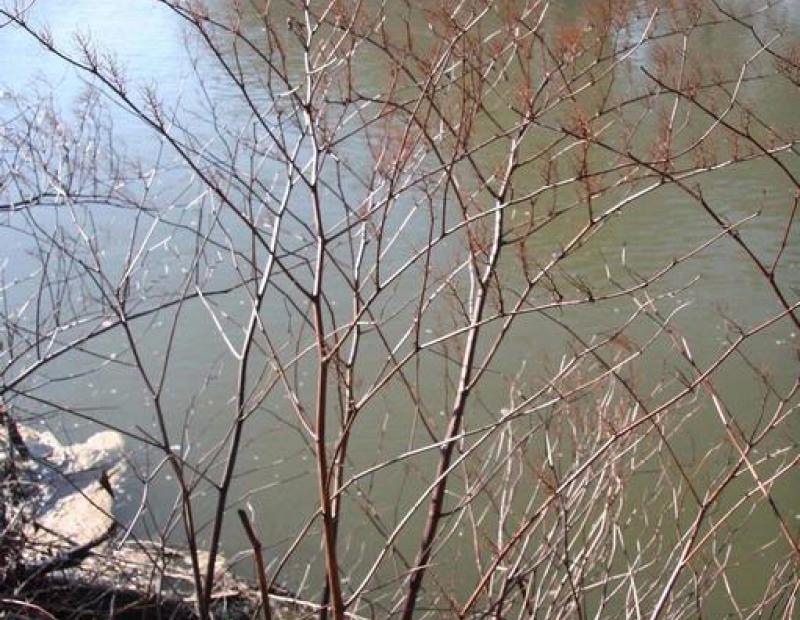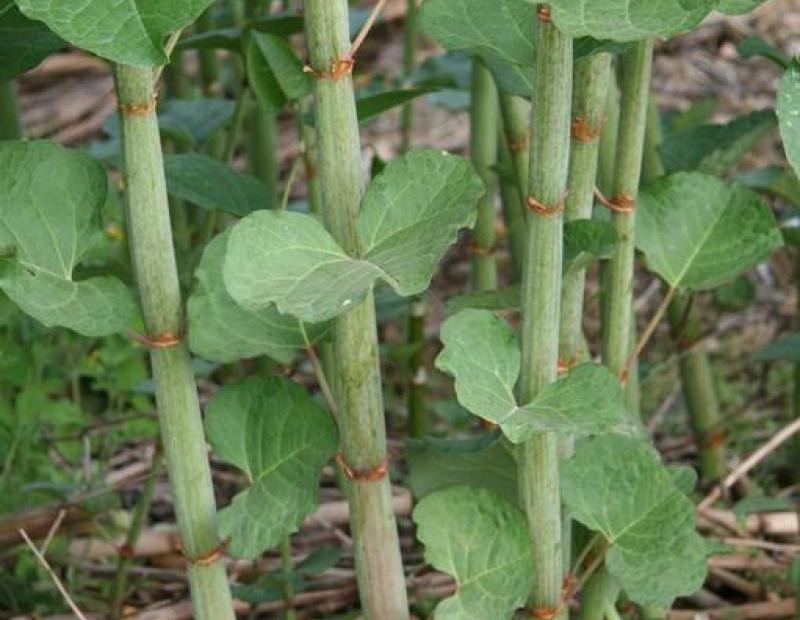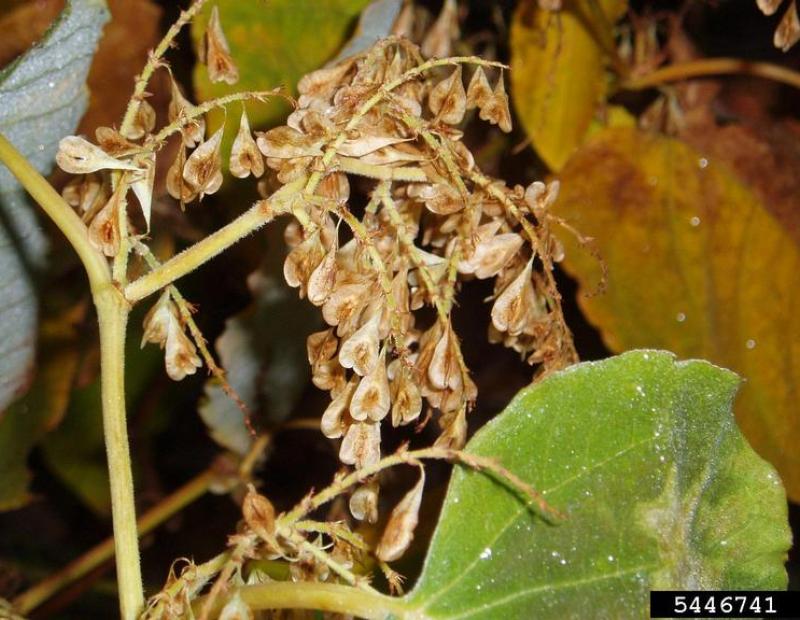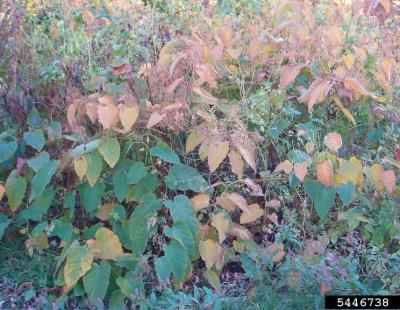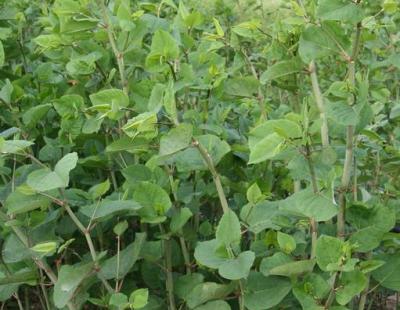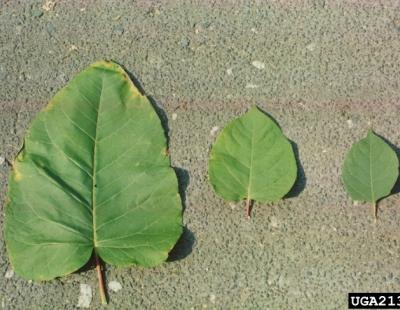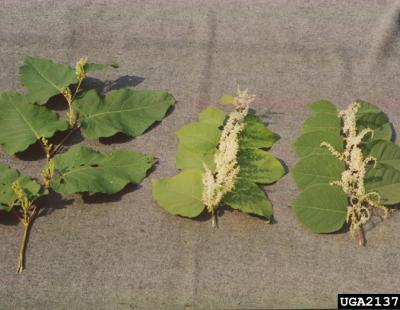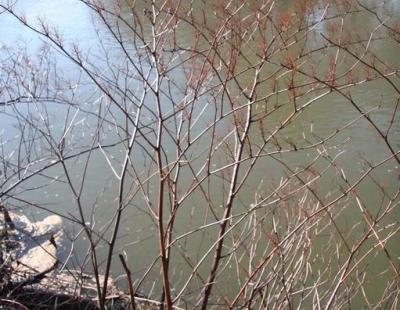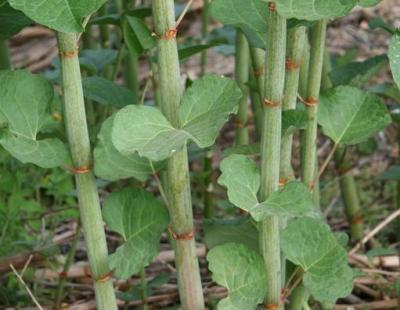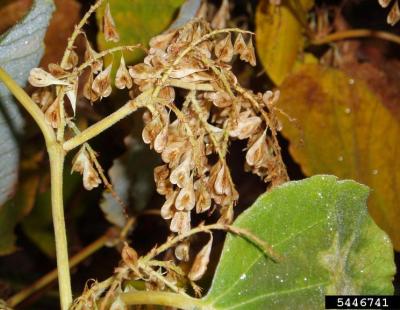Vertical Tabs
A tall, robust, semi-woody perennial that forms dense stands. Long-lived, extensive rhizomes can extend over 2 m deep and 7-20 m from the root crown. Annual stems are thick, hollow, and jointed, with swollen nodes. Stems grow 1-3 m tall and then die back to near ground level in autumn.
Knotweed flowers in late July-late September, and seeds develop in August-October. Seeds may be sterile or viable depending on the plant.
Bohemian knotweed (Polygonum × bohemica) is a hybrid between Japanese knotweed (P. cuspidatum) and giant knotweed (P. sachalinensis). In the northeastern US, all three knotweeds are present.(1) Because they are difficult to distinguish and have similar ecological characteristics, we discuss them together as simply “knotweed.”
Leaves
Leaves are alternately arranged, simple, broadly ovate, and variable in shape. Leaf bases may be heart or spade shaped. Bohemian knotweed leaves are ten inches long and up to seven inches wide. (4)
A highly aggressive, quickly spreading perennial, knotweed is arguably one of the most destructive invasive species in the world. Capable of creating dense stands, outcompeting native plants and limiting light levels for germinating vegetation, knotweed can also cause damage to building foundations, drainage pipes and sidewalks in the urban areas it invades. (5) Furthermore, homogenous stands of thess species compromise the stability of fragile soils in riparian areas, making these areas more at risk of erosion.
Biological Control
The knotweed pysillid, Aphalara itadori, is currently under review as a candidate for biological control, although its use has not yet been approved. The sap sucking insect has already been released for knotweed management purposes in the UK. (7)
Manual or Mechanical Control
Pulling / Digging Up: Pulling by hand is an ineffective method of control and will stimulate increased growth due to rhizome fragmentation. (8)
Mowing: In small populations mowing or hand cutting at least three times during the growing season appears to diminish bohemian knotweed’s ability to re-sprout. Although eradication via this method of management is unlikely, persistent cutting will shrink the infestation. (8)
Girdling: Not applicable
Prescribed Fire: Studies suggest knotweed’s deeply buried rhizomes provide fire tolerance to the species. Top-killed individuals rapidly re-sprout after a burn. (6)
Prescribed Grazing: Although knotweed is palatable to livestock, grazing will not suppress its growth, nor eradicate it. (6)
Soil Tilling: Not advisable. Tiling will fragment roots and encourage re-sprouting and vigorous growth.
Mulching: Not applicable. Covering small infestations with a black tarp may help diminish the vigor of knotweed sprouts, however, it is not a particularly effective strategy. After all, the species is capable of emerging through tarmac. (8)
Solarization: Not applicable
Hot Foam Spray: Not applicable
Chemical Control
The pesticide application rates and usage herein are recommendations based on research and interviews with land managers. When considering the use of pesticides, it is your responsibility to fully understand the laws, regulations and best practices required to apply pesticides in a responsible manner. At times, the pest you seek to treat may not be on a pesticide label, requiring a 2ee exemption from NYSDEC. Always thoroughly read the label of any pesticide and consult the NYSDEC or a licensed pesticide applicator with questions.
Foliar Spray: A 3-8% foliar spray of glyphosate is effective against knotweed if used consistently and after a mid-season cutting. Cut knotweed stems and allow the shoots to regrow for approximately three weeks before spraying. Always read and follow all directions on the label. Follow up treatment will be necessary the following season. (8)
Cut Stump: Cut knotweed stems from mid-summer onwards and drip a 20% solution of glyphosate into the hollow stem. This treatment will likely need to be followed up with a foliar spray in the following season as new, smaller sprouts emerge. (9)
Basal Bark: Not applicable
Hack-And-Squirt
Stem Injection: Similar in principle to cut stump treatments, stem injections use a special gun to inject a solution of 20% glyphosate into knotweed’s hollow stems. This treatment is less time consuming than cut stump with less opportunity for herbicide spillage. A follow up with foliar spray will be necessary as new, smaller sprouts emerge from the rhizome. (9)
Pre-Emergent Spray: Not applicable.
Sequential mowing or cutting coupled with sequential herbicide treatments will provide the highest rate of control of knotweed. Plants should be mowed or cut prior to foliar applications, and two applications may be necessary during the first year of control. As an alternative, managers may choose to use the stem injection method, eliminating the need for cutting. For very small infestations, cutting and spot spraying or stem injections will eventually achieve eradication.
Post treatment monitoring
Depending on the management method employed, controlled populations should be revisited throughout the growing season for repeat management activities, at least every 2-3 weeks. Knotweed is an extremely resilient plant and is quite resistant to herbicide treatments: after control is achieved, if achieved at all, the site should be inspected annually to manage inevitable re-sprouts.
REFERENCES
- Grimsby, J.L., and R. Kesseli. 2010. Genetic composition of invasive Japanese knotweed s.l. in the United States. Biological Invasions 12:1943-1946.
- Dommanget, F., T. Spiegelberger, P. Cavaille, and A. Evette. 2013. Light availability prevails over soil fertility and structure in the performance of Asian knotweeds on riverbanks: New management perspectives. Environmental Management 52:1453–1462.
- Stone, K.R. 2010. Polygonum sachalinense, P. cuspidatum, P. × bohemicum. In: Fire Effects Information System. U.S. Department of Agriculture, Forest Service, Rocky Mountain Research Station, Fire Sciences Laboratory. http://www.fs.fed.us/database/feis/ [Accessed 24 October, 2016].
- https://www.nobanis.org/globalassets/speciesinfo/r/reynoutria-japonica/r...
- https://www.ncbi.nlm.nih.gov/pmc/articles/PMC2802983/
- https://www.fs.fed.us/database/feis/plants/forb/polspp/all.html
- https://assets.publishing.service.gov.uk/government/uploads/system/uploa...
- https://www.invasive.org/weedcd/pdfs/tncweeds/polycus.pdf
- https://cipwg.uconn.edu/wp-content/uploads/sites/244/2014/12/VT_TNC-Inva...

